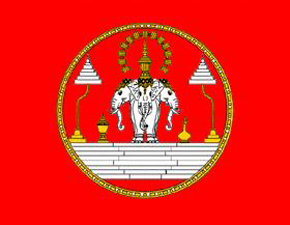and Medals of the Kingdom of Laos

by Ed Emering & John Sylvester, Jr.
Royal Laotian Flag
Brief History
The History of Laos and the Khun Lo Dynasty traces its roots to the establishment
of the Kingdom of Lan Xang (literally, "million elephants")
by King Fa Ngum in 1353. Under his rule, the wealthy and mighty kingdom
covered the northeast region of present-day Thailand, all of Laos and
present-day Stung Treng Province of Cambodia.
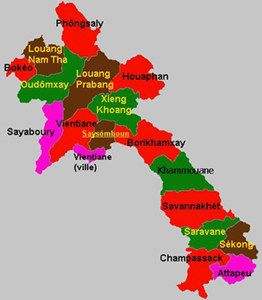 |
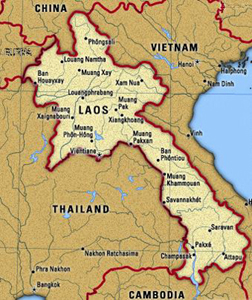 |
In late nineteenth and early twentieth centuries Laos, literally the land of a million elephants and white parasol, was composed of an amlgamation of three kingdoms: (1) Luang Prebang; (2) Vientiane and (3) Champassak. The stronger Siamese (Thai) neighboring monarchs ultimately controlled all three kingdoms, while the Vietnamese, living on the eastern side of the Annamite Cordillera also harbored designs on the territory of Laos.
In 1885, the French developed an interest in extending their sphere of influence in Southeast Asia to include Laos. While Chao Kham Souk ruled Champassak and Oun Khna ruled Luang Prebang, France with the permission of Siam established a Vice Consulate in Luang Prebang. In 1887, Siam removed its garrisoned troops from Laos. Luang Prebang was immediately sacked by the T’ai (not Thai) bandits under the leadership of Deo Van Tri. France came to the assistance of Luang Prebang, thus establishing domain over one-third of the country. Eventually France forced Siam to relinquish all claims to Laos. Auguste Pave was named France’s Commissioner General.
As the 1800s came to end, the King of Luang Prebang ruled over his own Province, plus Samneua and the Fifth Military District of the highland country. The Provinces/Regions of Vientiane and Champassak were directly administered by the French and their Vietnamese cronies with recognition of the Champassak Royal House. Laos was also garrisoned with French troops and the Native Guard (Garde Indigine).
With the invasion of the Japanese forces during WW II, King Sisavang Vong was coerced into declaring independence from France. Two internal opposition movements emerged. Prince Oum of Champassak headed an anti-Japanese movement and the Lao Issara, an anti-French movement also evoled. By war’s end the Chinese also occupied much of Laos.
In order to cement their return, the French arranged for unification of Laos under King Sisavang Vong, who reigned from 1904 to 1959. Laos was now independent with the sphere of the French Union.
At the conclusion of the Indochina War (1954), the Geneva Convention intended to create an independent Laos as a buffer state to the divided Vietnam. Hostilities soon broke out between occupying Vietnamese forces and Lao rightists.
In 1960, Kong Le, a paratroop captain, seized Vientiane in a coup and demanded formation of a neutralist government to end the fighting. The neutralist government, once again led by Souvanna Phouma, was not successful in holding power. Rightist forces under General Phoumi Nosavan drove the neutralist government from power later that same year. Subsequently, the neutralists allied themselves with the communist insurgents and began to receive support from the Soviet Union. Phoumi Nosavan's rightist regime received support from the U.S.
A second Geneva conference, held in 1961-62, again provided for the independence
and neutrality of Laos returned Prime Minister Souvanna Phouma to power.
Soon after accord was reached, the signatories accused each other of violating
the terms of the agreement, and with superpower support on both sides,
the civil war soon resumed. Although the country was to be neutral, a
growing American and North Vietnamese military presence in the country
increasingly drew Laos into the Second Indochina War (1954-1975). For
nearly a decade, Laos was subjected to the heaviest bombing in the history
of warfare, as the U.S. sought to destroy the Ho Chi Minh Trail that passed
through eastern Laos.
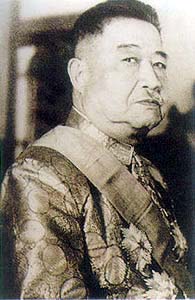
King Sisavang Vong
The fall of Saigon and Phnom Penh to communist forces in April 1975 hastened
the decline of the coalition in Laos. Months after these communist victories,
the Pathet Lao entered Vientiane.
King Savang Vathana, who had reigned as King (1959-1975) and Grand Master
of the most esteemed Order of the Million Elephants and the White Parasol,
and of the Orders of Education, Agricultural Merit, and Civil Merit, and
was the founder of the Orders of the Crown of Laos and Feminine Merit,
was forced to abdicate by the Communists on November 29, 1975. This cleared
the way for the communist Lao People's Democratic Republic (LPDR) to be
established
The King was subsequently removed to a "re-education” camp in the northeastern province of Houaphan, together with the Queen and the Crown Prince Sri Savangsa on March 11, 1977. They were never seen or heard from again and were assumed to have died in the camp.
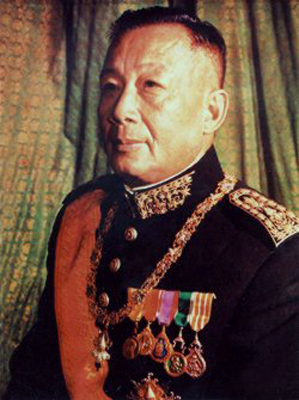
King Sisavang Vathana wearing the Order of the Million
Elephants and White Parasol Grand Cross with Plaque and from left to right
Order of the Reign, Order of the Crown, Medal for Excellence in Education,
Order of Agricultural Merit and Order of Civic Merit
The Royal Family Today
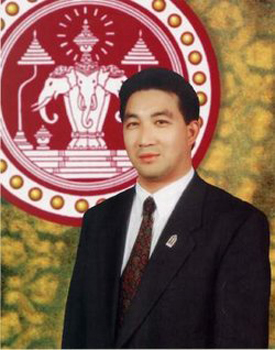
H.R.H. Prince Soulivong Savang
H.R.H. Prince (Sadet Chao Fa Jaya) Sulinga Varman Savangsa (Soulivong Savang), is the current Head of the Royal House of Laos. He is the eldest son of H.R.H. Crown Prince (Anga Mahkuta Rajakumara) Varman Savangsa (Vong Savang) and H.R.H. Crown Princess (Anyi Mahkuta Raja Kumari) Manikyalan. He became Heir Apparent on the presumed death of his father, May 2, 1978 and became Head of the Royal House of Laos on the presumed death of his grandfather in March 1980. He escaped across the Mekong River from communist Laos into Thailand together with his second brother, on a raft made of banana palm trunks on August 3, 1981 and settled in France with other surviving members of the Lao royal family.
The Royal Orders
During the twentieth century, the Royal Laotian government developed a system of Orders and Medals under French Influence. The system was extended in the 1950s and early 1960s following French involvement in Indochina. Two additional medals appeared toward the end of the reign (1970s), but their purpose remains unknown and their significance a mystery.
Order of the Million Elephants and White Parasol
The Order was created by Sisavang Vong, the King of Luang-Prabang on May 1, 1909 to recognize exceptional military and civil service. It is originally awarded in one, then four and finallythe traditional five European classes (Grand Officer, Grand Cross, Commander, Officer and Knight). The uniface insignia is composed of three white enamel elephants with red enamel headpieces suspended beneath a golden crown, surmounted by a stylized parasol. The Knights badge is 56mm and the other levels, 62mm. It was widely awarded to French officials and military personnel, including those who participated in the Franco-Laotian Resistance (against the Japanese) in 1944 and to members of the French Military Mission and the French Expeditionary Corps, which participated in the Laotian War.
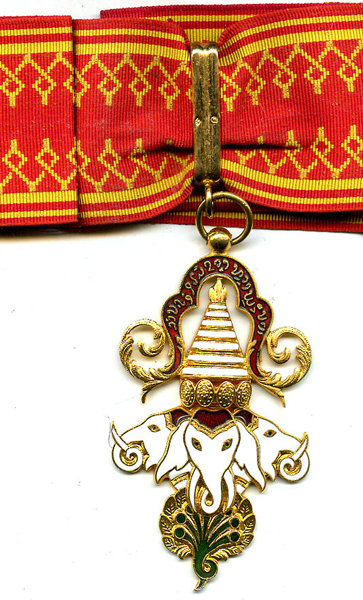 |
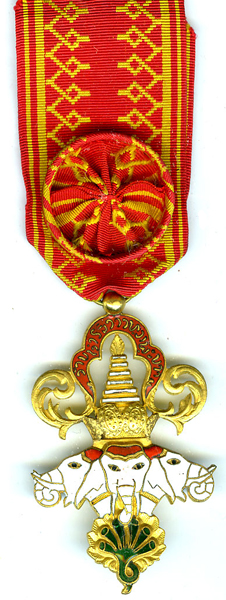 |
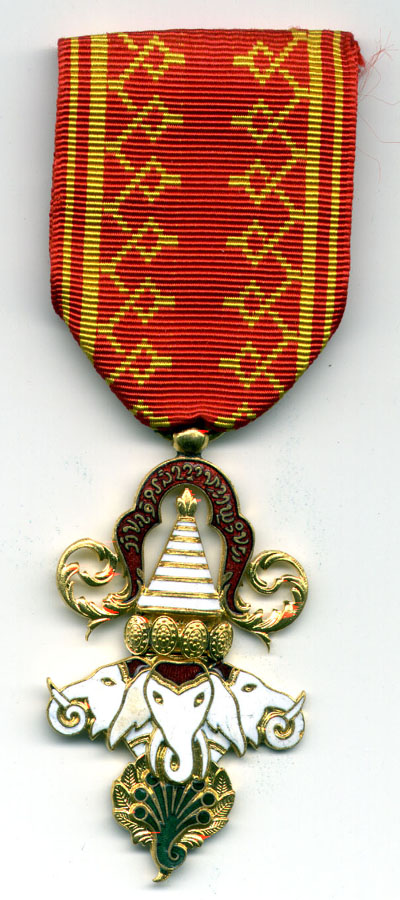 |
Order of the Million
Elephants and White Parasol Commander, Officer and Knight Grades |
||
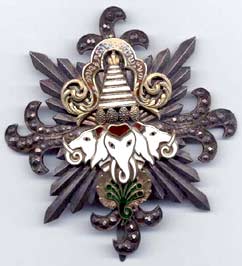
Plaque
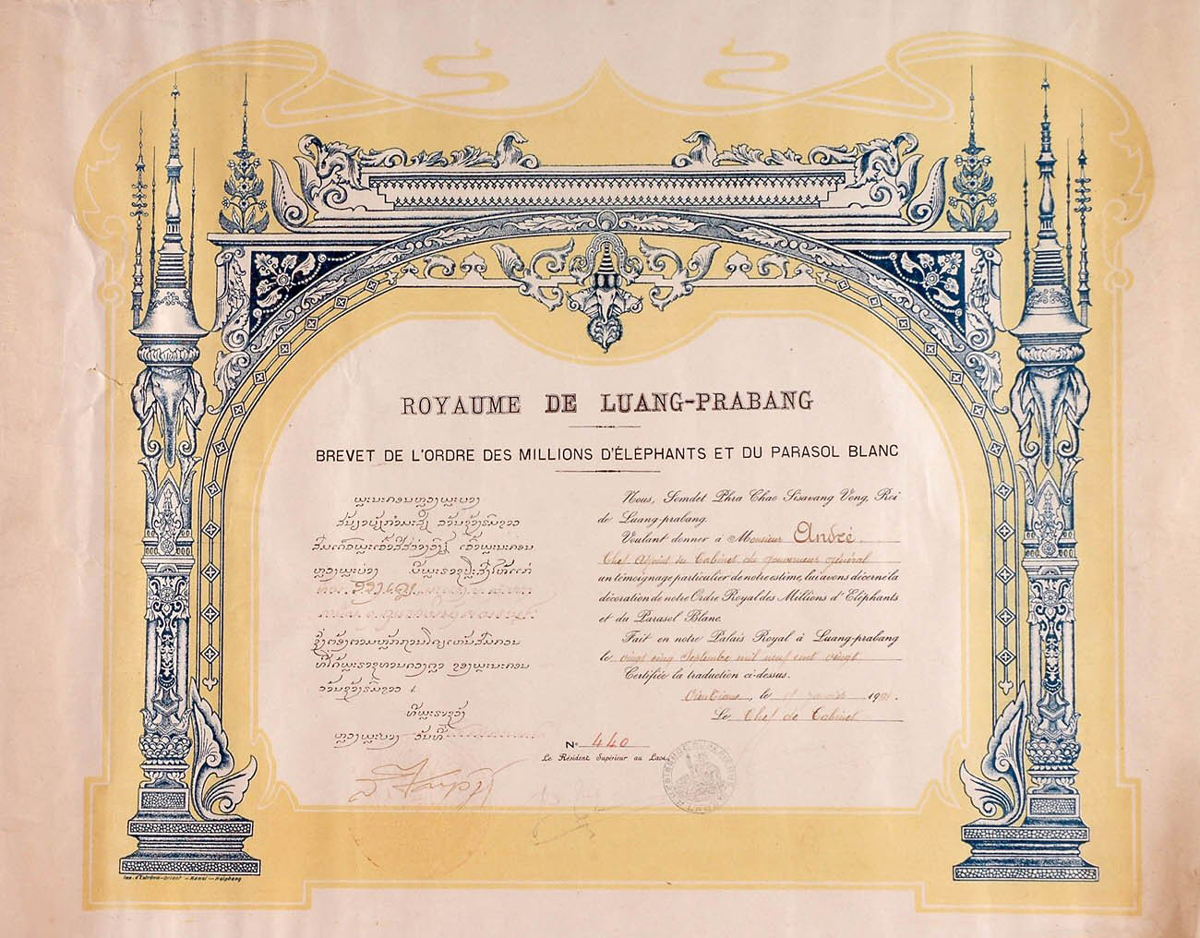
Order of the Million Elephants and White Parasol Award Document
Order of the Crown of Laos
Instituted in 1962, this Order is awarded to Members of the Royal Family in the traditional five European classes (Grand Cross, Grand Officer, Commander, Officer and Knight). The red enamel center of the gold rimmed planchet features the Royal arms consisting of a three-headed elephant on a foundation of steps with seven-tired Royal parasols on each side and Laotian crown and halo above suspended from a Royal crown. The reverse is blank.
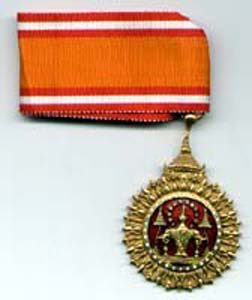
Order of the Crown Commander
Order of the Reign
Instituted in 1927, the 32mm Order is awarded in three classes (gold, silver and bronze) for meritorious or long and faithful service to the monarchy. There are three variations of the Order each featuring the profile of a monarch. The first variation, issued by King Sisavang Vong, is inscribed, KING SISAVANG VONG ROI DE LUANG PRABANG. It is suspended from a horn-like curliqueholding a Royal crown and halo. The reverse features the Royal Lao coat-of-arms, the three-headed elephant in the center with the inscription, SOMDET PHRA CHAO LAN SANG HOM KHAO LUANG PRABANG AROUND THE EDGE.
The second variation features the obverse and reverse inscriptions, SISAVANG VONG ROI DU LAOS and SOMDET PHRA CHAO LAN SANG HOM KHAO PHRA RAJAANACHAK LAO, respectively.
The third variation features the obverse inscription, S. M. BOROMA STHA KATYA SOURYAVONGSA PHRA MAHA SRI SAVANG VATHANA ROI DU LAOS. The reverse is the same as variation two.
 |
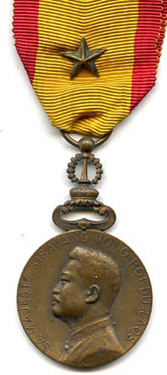 |
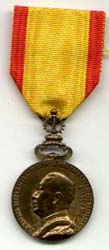 |
Order of the Reign
Variations 1, 2 and 3 |
||
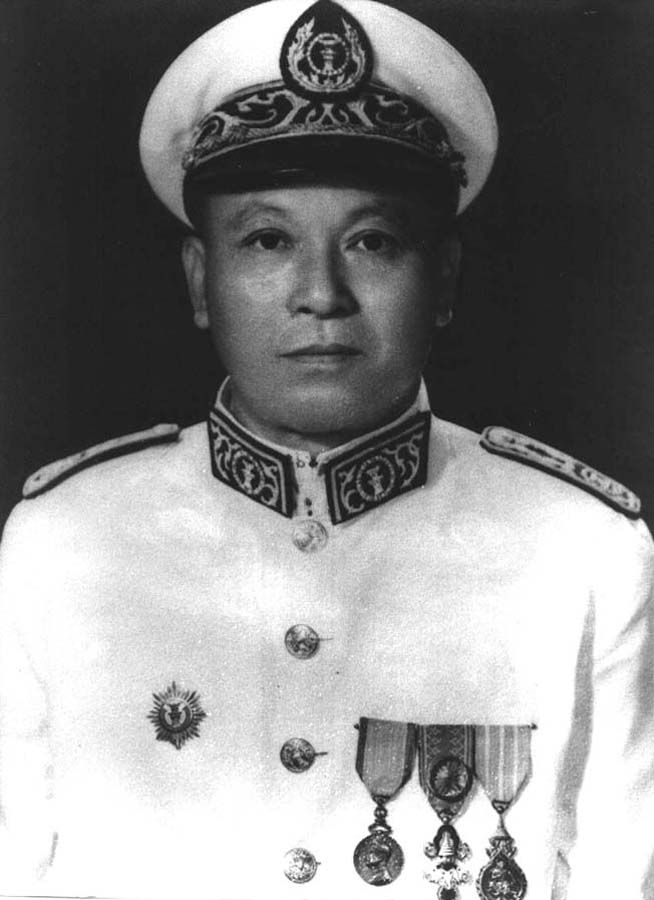
Royal Lao Officer with Order of the Reign, Order of the
Million Elephants and White Parasol and Order of Civic Merit
Order of Civic Merit
Instituted in 1959, the 34mm Order is awarded in three classes (Commander, officer and Knight) for meritorious and courageous service by civil officials and military personnel. The obverse features the silver figure of the monkey, Hanuman, holding a sword on a red enamel background surrounded by frieze of small ribbon protuberances suspended by a Royal crown. The reverse is blank.
 |
 |
Orders of Civic
Merit and Agricultural Merit |
|
Order of Agricultural Merit
Instituted in 1950, the 35mm Order is awarded in three classes (Commander,
officer and Knight) for meritorious service in the fields of economy and
agriculture. The obverse features a female dancer in silver on a light-green
enamel background surrounded by a
gold wreath. The reverse is plain. The suspension is a Royal Lao crown.
Order of Feminine Merit
The 38mm Order was awarded in a single class to women for meritorious deeds. The obverse features two feminine figures in gold on a silver-blue enamel background surrounded by a gold frieze of points and branched curlicues.
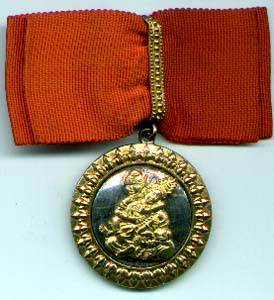
Order of Feminine Merit
The Medals
Medal for Excellence in Education
The 37mm Medal for Excellence in Education, often termed an Order, was instituted in 1955 and like the Orders is also awarded in three classes (Commander, Officer and Knight) for meritorious service in the field of education. The obverse features the bust of a three-faced goddess in gold on a background of blue enamel, surrounded by a gold wreath joined at the top by a Royal crown. The reverse is blank.
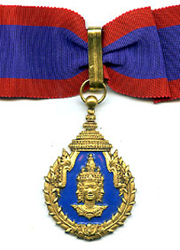 |
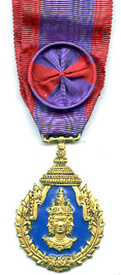 |
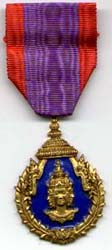 |
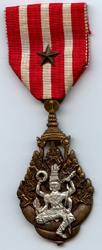 |
Medal for Excellence
in Education (Commander, Officer and Knight) and Medal for Military Valor |
|||
Medal for Military Valor
The extremely rare Medal for Military Valor was instituted in 1957 and awarded for bravery in combat. The obverse features the four-armed god, Sita, seated cross-legged on a bronze seven-headed mythological snake (Naga) with a Royal crown at the top. The reverse is blank. It was awarded with a series of devices on the ribbon drape as follows: (1) gold star – Order of the Corps; (2) silver star – Order of the Division; (3) bronze star – Order of the Brigade and (4) bronze palm – Order of the Army.
Combat Veteran’s Medal
Instituted in 1957, the 30mm Combat Veteran’s Medal was awarded for service during hostilities in the late 1950s and early 1960s. The obverse features the Royal Lao Army symbol, a trident with silver blades and a gold handle mounted on a weapon disk (Chaka) against a background of red enamel. With a gold edge leading to a Royal crown with the visage of mythological lions on either side at the top. The reverse features the Royal Lao coat-of-arms, the three-headed elephant with the inscription MEDAILLE DU COMBATTANT in French on the right and in Lao script on the left.
 |
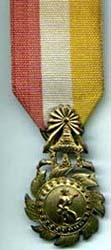 |
Combat Veteran’s
Medal and Medal of Government Gratitude |
|
Medal of Government Gratitude
Instituted in 1962, the34mm gold Medal of Government Gratitude was awarded for service during the 1960-1961 campaign. The obverse features a walking soldier with rifle surrounded by a knobbed circle and outside of that a circle of protruding flames and a Royal crown with pointed-rays at the top. The reverse has the circular inscription 1960-61 at the bottom and Lao script n the top and middle.
Franco-Laotian Resistance Medal
This medal, established on Apr. 25, 1949, was for Lao and French who participated in the struggle against the Japanese occupiers during World War II (and perhaps some who fought subsequently against the Lao Issara). It might be better described as an award of France rather than Laos.
The round bronze 31mm badge pictures the three headed elephant and seven tiered parasol above, with curlicues and the Cross of Lorraine on either side, and, around the edge, at the top in small letters the inscription RESISTANCE FRANCO LAOTIENNE 10 MARS 1945 - 25 AOUT 1945, and at the bottom the comparable Lao inscription. The reverse has a curled dragon with a border of curlicues and in the center a blank straight area for the engraving of the recipientís name.
The medal was manufactured by the La Monnaie de Paris. It has become very rare and expensive.
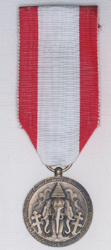
Two Unknown Medals
Many have ventured guesses at the purpose of these two medals, but I am convinced after decades of research that their purpose remains unknown. The crown suspensions indicate that they are “royal” in nature. They are plentiful in the medal collector markets and have become accepted as the “Unknown Medals.”
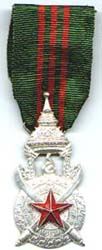 |
 |
Conclusion
The Royal system of Orders and Medals effectively ended with the fall of Laos in 1975. The Royal Orders, by their nature, remain the dynastic property of the Royal House of Laos in absentia.
